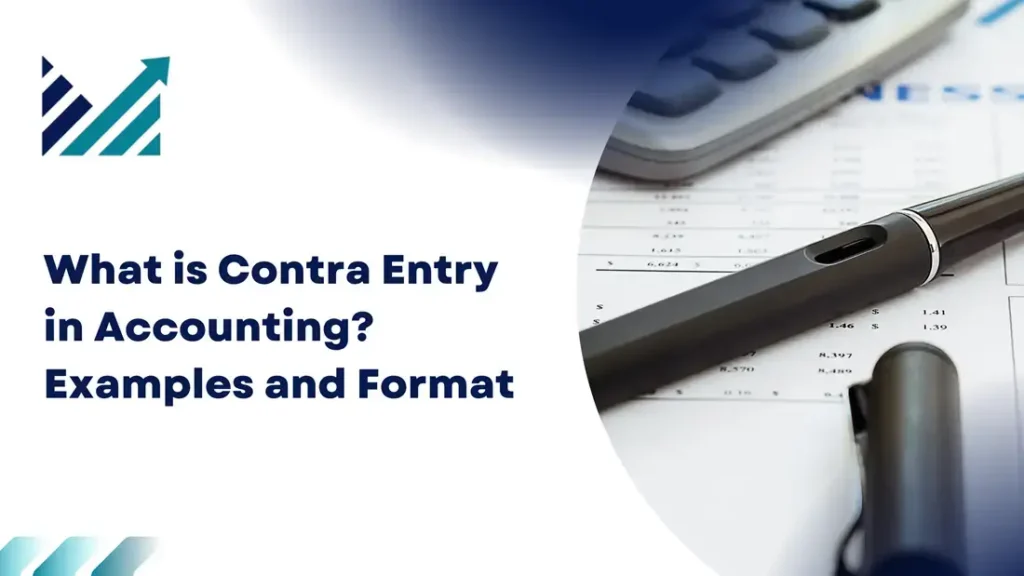
Introduction to Contra Entry
Think about your daily business routine. Did you deposit cash into your bank account today? Maybe you withdrew cash from an ATM for office expenses? Or perhaps transferred money from one business bank account to another?
If yes, congratulations—you’ve just performed what accountants call a contra entry.
Though the term might sound technical, contra entries are quite common in day-to-day business accounting. They ensure accurate reflection of how money moves within your organization—specifically between cash and bank accounts.
In this article, we’ll explain what a contra entry is, why it matters, how to record it, its format, and provide clear examples. Whether you’re a student, a business owner, or someone brushing up on accounting basics, this guide will help you understand contra entries confidently.
What is a Contra Entry in Accounting?
In accounting, a contra entry refers to a transaction that affects both the cash account and the bank account. The term “contra” comes from Latin, meaning “against” or “opposite.”
Simply put, if you move funds from cash to bank, from bank to cash, between two bank accounts, or even between two cash accounts like the main cash and petty cash, it’s a contra entry.
These transactions don’t impact your overall business income or expenses—they merely shift the funds from one pocket to another. That’s why they are usually recorded in a double column cash book, where both sides of the entry appear together.
Types of Contra Entry in Accounting
There are four common types of contra entries:
- Cash account to bank account
For example: depositing office cash into the bank. - Bank account to cash account
For example: withdrawing cash from bank for office use. - Bank account to bank account
For example: transferring money from your current account to savings account. - Cash account to cash account
For example: transferring funds from the main cash account to petty cash.
Why include cash-to-cash?
Businesses often maintain a petty cash account for small, day-to-day expenses like stationery or refreshments. When the main cash account funds the petty cash account, that’s also recorded as a contra entry.
Purpose of Contra Entries
The main purpose of contra entries is to track the internal movement of funds between cash and bank accounts.
They help businesses:
- Maintain accurate cash and bank balances.
- Prevent errors or omissions in records.
- Easily reconcile bank statements.
- Improve financial transparency.
Contra entries do not affect the profit & loss statement, because they don’t involve external income or expenses. They only rearrange how your liquid assets are held.
Examples of Contra Entries
Let’s look at practical business examples to make this clearer.
| Entries | Is it Contra Entry? | Reasoning |
| Transferred cash to petty cash, 2,500 IDR | Yes | Moves funds from main cash to petty cash account. Both are cash accounts. |
| Deposited 10,000 AED into bank | Yes | Funds move from cash to bank. |
| Withdrew 2,500 AED from bank for office use | Yes | Funds move from bank to cash. |
| Transferred 5,000 AED from Bank A to Bank B | Yes | Moves funds between two bank accounts. |
| Paid rent by cheque 2,500 AED | No | Only affects bank account; other side affects expense (rent). |
| Cash sales 1,750 AED | No | Only increases cash; other side affects revenue. |
| Purchased stationery 1,000 AED | No | Only affects cash; other side affects expense. |
Remember:
A contra entry always affects both sides: cash and/or bank.
Also Read: Accounting Standards in Dubai, UAE
Double Column Cash Book: Format for Contra Entries
To record contra entries properly, accountants use a double column cash book.
This special book has:
- Two columns on the debit side: Cash and Bank.
- Two columns on the credit side: Cash and Bank.
Here’s a simplified format:
| Date | Particulars | Ref | L.F | Cash (Dr) | Bank (Dr) | Date | Particulars | Ref | L.F | Cash (Cr) | Bank (Cr) |
| 09/08 | To Bank | C | 2,500 | – | 09/08 | By Cash | C | – | 2,500 | ||
| 21/08 | To Cash | C | – | 10,000 | 21/08 | By Bank | C | 10,000 | – |
Note: The letter C in the L.F (Ledger Folio) column indicates it’s a contra entry, and no separate ledger posting is required.
This makes it easy to spot contra entries at a glance.
How to Record Contra Entries
Using the double-entry system, each contra transaction records two parts:
- Debit: where money is going to.
- Credit: where money is coming from.
Let’s see this in simple terms.
Example 1: Deposit cash into bank
- Debit: Bank account (money goes into bank)
- Credit: Cash account (money comes out of cash)
| Account | Debit | Credit |
| Bank | 10,000 | – |
| Cash | – | 10,000 |
Example 2: Withdraw cash from bank
- Debit: Cash account (money comes into cash)
- Credit: Bank account (money goes out of bank)
| Account | Debit | Credit |
| Cash | 2,500 | – |
| Bank | – | 2,500 |
Example 3: Transfer from Bank A to Bank B
- Debit: Bank B
- Credit: Bank A
| Account | Debit | Credit |
| Bank B | 5,000 | – |
| Bank A | – | 5,000 |
Example 4: Transfer to petty cash
- Debit: Petty Cash
- Credit: Main Cash
| Account | Debit | Credit |
| Petty Cash | 2,500 | – |
| Main Cash | – | 2,500 |
Contra Entries between AR and AP
While most contra entries happen within cash/bank accounts, sometimes businesses use contra entries to offset accounts receivable (AR) and accounts payable (AP) between two companies.
Example:
Company A has $6,000 receivable from Company B.
Company A also owes Company B $3,000.
To offset:
- Debit: Accounts Payable (reduce liability)
- Credit: Accounts Receivable (reduce asset)
| Account | Debit | Credit |
| Accounts Payable | 3,000 | – |
| Accounts Receivable | – | 3,000 |
This keeps records clean and balances updated.
What Rules Are Followed for Contra Entries?
Under double-entry accounting, every debit must have a corresponding credit.
Contra entries follow the same rule, but both debit and credit go into cash/bank accounts.
Key points:
- Debit entry reverses or offsets an entry on the credit side.
- Both sides are recorded in the same cash book.
- Contra entries get marked with a C in the L.F. column.
- They don’t need posting to the ledger separately.
Benefits of Using Contra Entries
- Keeps accurate records of internal transfers.
- Saves time by avoiding separate cash and bank ledgers.
- Helps in cash flow planning.
- Makes bank reconciliation simpler.
Double Entry Cash Book: Format in Detail
A double entry cash book combines cash and bank columns to track receipts and payments.
Here’s how it usually looks:
| Dr (Receipts) | | | | | | Cr (Payments) | | | | |
|—-|—-|—-|—-|—-|—-|—-|—-|—-|—-|
| Date | Description | V.No. | PR | Discount | Cash | Date | Description | V.No. | PR | Discount | Cash |
Discount columns record cash discounts allowed (Dr side) and received (Cr side).
Conclusion
Contra entries may look complex at first, but they’re just records of internal fund transfers that keep your cash and bank records accurate.
They don’t affect your business profits directly, but they are vital for internal control, transparency, and reconciliation.
If you’re using accounting software, these entries are often created automatically. But knowing how and why they work will help you review your books confidently.
Key takeaway:
- Contra entries always affect cash and/or bank accounts.
- Use a double column cash book to record them.
- Mark them clearly to avoid double posting.
Want to simplify accounting for your business?
Consider expert help from audit firms in Dubai—so you can focus more on running your business than recording it.

